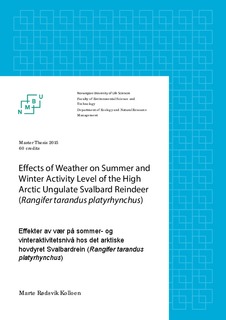| dc.description.abstract | Animals are evolutionary adapted to certain weather conditions, but as the climate of the earth is changing many species may face new and significant challenges in their environment. The high-Arctic species Svalbard reindeer are living in extreme and unpredictable surroundings with large seasonal changes in their climatic environment. Physiological studies have found that Svalbard reindeer are adapted to low winter temperatures and high wind speeds. However, no long-term studies have investigated the effect of altering weather on the activity level in Svalbard reindeer, or if the animals show signs of cold or heat stress. The latter is of high interest, as the temperature on Svalbard has been rising during the last decades and is expected to continue to do so.
In this study I wanted to reveal how activity levels changed under altering weather conditions, especially under extreme and rare weather events. I specifically wanted to examine whether there were any threshold values where activity abruptly dropped. Adult female reindeer in Nordenskiöld land at Svalbard were equipped with GPS collars with integrated activity sensors during the years 2009-2014 (a total of 108 animal years). Activity levels were recorded continuously and stored in the collars every 5 minutes. Analyses were conducted for the seasons summer (July and August) and winter (December and January), and the included weather variables were temperature (°C), wind speed (m/s), precipitation (mm) and calculated wind chill (perceived temperature in °C).
I found effects of all four weather variables on the activity level of Svalbard reindeer, both during summer and winter. Svalbard reindeer reduced activity levels both at high and low temperatures during summer, potentially indicating both heat stress and cold stress during this season. Both an upper and lower temperature threshold value could be identified. During winter, activity was at its highest at low temperatures, substantiating that Svalbard reindeer are adapted to a cold climate. Activity levels decreased with increasing winter temperatures, but showed no signs of abrupt change and no threshold value could be identified. The same pattern as for temperature could be seen for windchill. With increasing wind speed, activity increased during summer. During winter, however, activity decreased with increasing wind speed. For both seasons, activity levels were reduced when there was precipitation compared to when there was not.
This study contributes to the understanding of activity levels in ungulates under altering weather conditions. In addition, knowing how a high-arctic species like Svalbard reindeer responds to variations in extreme weather events helps us understand how this species will persist in a future with a changing climate. | nb_NO |
